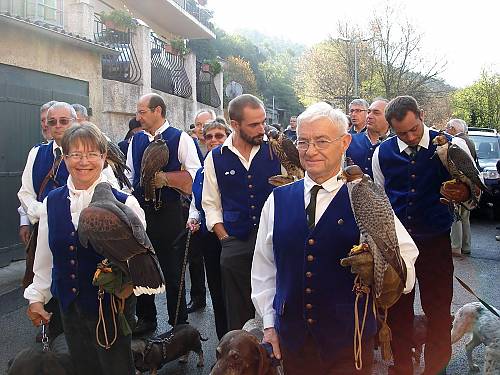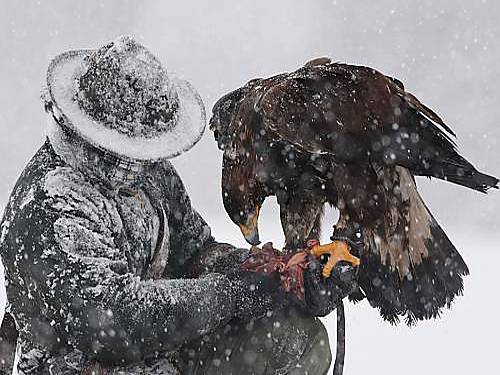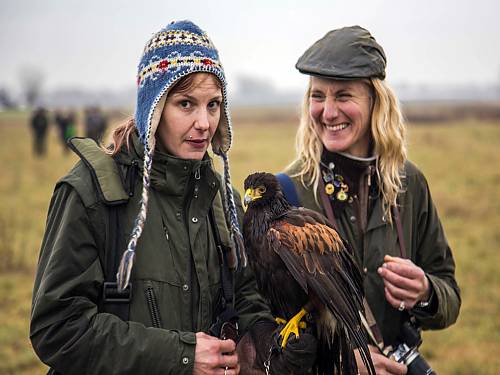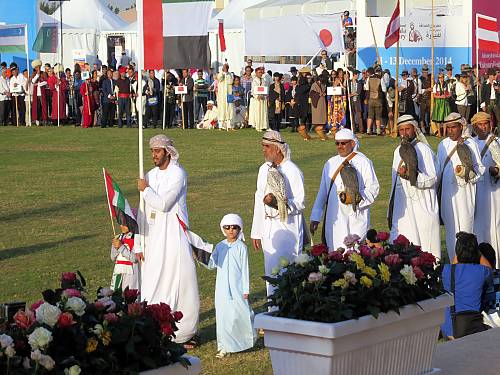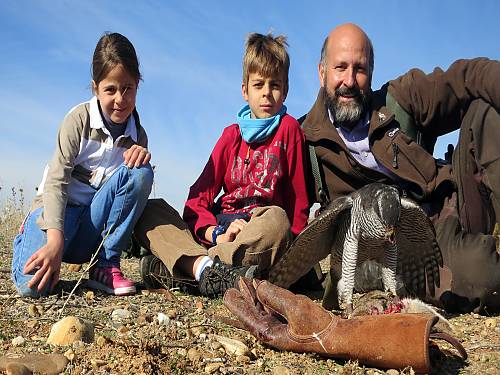Inscribed in 2016 (11.COM) on the Representative List of the Intangible Cultural Heritage of Humanity
1.1 Description of the element
Originally a method of obtaining food, the practice of falconry has evolved over time to be more associated with nature conservation, cultural heritage and social engagement within and amongst communities. Following their own set of traditions and ethical principles, falconers train, fly and breed birds of prey (which includes besides falcons, birds such as eagles and hawks) developing a bond with them and becoming their main source of protection. The practice, present in many countries around the world, may vary regarding certain aspects, for example the type of equipment used but the methods remain similar.
Falconers regard themselves as a group and may travel weeks at a time engaging in the practice, while in the evenings recounting stories of the day together. They consider falconry as providing a connection to the past, particularly for communities for which the practice is one of their few remaining links with their natural environment and traditional culture. Knowledge and skills are transmitted in an intergenerational manner within families by formal mentoring, apprenticeship or training in clubs and schools. In some countries, a national examination must be passed in order to become a falconer. Field meets and festivals provide opportunities for communities to share knowledge, raise awareness and promote diversity.
1.2 Geographical location and Range of the element:
United Arab Emirates, Austria, Belgium, Czechia, France, Germany, Hungary, Italy, Kazakhstan, Republic of Korea, Mongolia, Morocco, Pakistan, Portugal, Qatar, Saudi Arabia, Spain and Syrian Arab Republic.
Falconry is practised along the migration routes used by falcons for thousands of years. Thus falconry is mainly found within these traditional migration flyways and corridors that run from north and east Asia and north Europe through Mediterranean Europe, the Middle East and the Caspian Sea countries to North Africa, and from North America, south to Central and South America. Falconry is found in more than sixty countries. It depends on open terrain so that the falconer can follow the bird. Thus, habitat dictates the practicality of falconry and shapes its particular local variations of traditional styles. For example, in the deserts of Arabia, the open terrain allows the use of falcons that fly long distances, and the steppes of Asia permit the flying of both falcons and large eagles. However, in forested areas and mixed farmland, as found in much of Europe as well as Japan, parts of China, Republic of Korea and Pakistan, short-range birds, such as goshawks and sparrow hawks, are preferred. Spain and Italy provide opportunities to fly both short and long-wing birds of prey according to varying habitat.
Falconry retains an unbroken tradition in central, south and east Asia, the Middle East, North Africa and most parts of Europe. Following a brief decline in 18-19th century Europe, it is recovering and provides a link to the countryside by increasingly urban populations. When settlers from Europe reached the Americas, southern Africa and Australasia, they took many of their traditions along with them, including falconry. Falconry is even present in the Azores islands.In most countries falconry is a stable minority activity. However, in some areas rapid urbanisation has restricted the opportunity to practise falconry, leading to a decline. The migration from the countryside to towns is a major threat to rural-based traditions
1.3 Domain(s) of the element:
Domain(s) of the element as intangible cultural heritage identified according to the Article 2.2 of the Convention
- Oral traditions and expressions, including language as a vehicle of the intangible cultural heritage
- Social practices, rituals and festive events
- Knowledge and practices concerning nature and the universe
- Traditional craftsmanship
Evaluation Body Decision
Decision 11.COM 10.b.15
The Committee,
1.Takes note that United Arab Emirates, Austria, Belgium, Czechia, France, Germany, Hungary, Italy, Kazakhstan, Republic of Korea, Mongolia, Morocco, Pakistan, Portugal, Qatar, Saudi Arabia, Spain and Syrian Arab Republic have nominated Falconry, a living human heritage (No. 01209) for inscription on the Representative List of the Intangible Cultural Heritage of Humanity:
2.Decides that, from the information included in the file, the nomination satisfies the following criteria:
R.1:Falconry, as a traditional art and practice of keeping, training and flying a bird of prey to take quarry in its natural state, practised by people of all ages, genders and statuses, is recognized by its community members as part of their cultural heritage. It is a social tradition promoting respect for nature and the environment, transmitted from generation to generation through formal and informal means, and providing its communities with a sense of belonging, pride, continuity and identity;
R.2:The inscription of the element on an extended basis on the Representative List could further contribute to fostering cultural diversity, mutual understanding and intercultural dialogue worldwide, thus enhancing visibility and awareness of intangible cultural heritage and its importance in connection with its natural environment. It could further highlight the diversity of human creativity in the expression of a common traditional practice;
R.3:Efforts already underway in many countries with the full involvement of communities to safeguard falconry and ensure its transmission, focusing especially on apprenticeship, handicrafts, research and conservation of falcon species, are supplemented by planned measures to strengthen its viability and raise awareness both at national and international levels;
R.4:Communities, associations and individuals concerned have participated in the elaboration of this nomination at all stages and have provided plentiful evidence of their free, prior and informed consent;
R.5:Falconry is included on inventories of intangible cultural heritage in each of the submitting States. These inventories are maintained by relevant authorities in each submitting State and are regularly updated.
3.Inscribes Falconry, a living human heritage on the Representative List of the Intangible Cultural Heritage of Humanity;
4.Takes note that the present inscription replaces the 2012 inscription of Falconry, a living human heritage, in conformity with Chapter I.6 of the Operational Directives.
